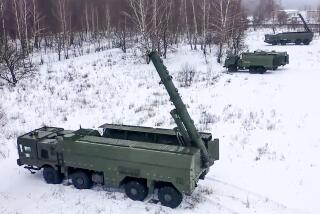U.S. Emergency Plan Elaborate, Untested
- Share via
WASHINGTON — Government officials have instituted elaborate safety programs to evacuate those who live near nuclear power plants if disaster strikes, but success would depend on a combination of efficiency, courage, wind direction--and luck.
Other than occasional exercises--such as moving a busload of students from a school or gathering highway patrol officers and local police at a highway checkpoint--the emergency plans have never been used.
Thus, no one is quite sure what would happen if a mass evacuation became necessary in the event of a disaster such as the radiation release and power plant fire at Chernobyl. Among the critical unanswered questions:
--Would the initial warning system of sirens and radio broadcasts work rapidly enough to alert citizens without causing a panic?
--Would designated bus drivers go to schools and hospitals to pick up people, perhaps braving passage through a zone of radiation, or would they rush in the opposite direction?
--Would parents follow the planned routes out of the city, or would they jam the streets around schools, trying to get their children?
Questions Answered
To nuclear power’s critics, the questions practically answer themselves.
“The plans count on city officials and workers to go into the area and take people out,” said Stephanie Murphy of the Washington-based Nuclear Information and Resource Service, an anti-nuclear group that supports safe energy alternatives. “But who will be willing to go in and evacuate stranded people if there is a lot of radiation?”
However, the federal officials who worry about safety are convinced that their preparations for evacuation are sound. After the accident and radiation release at Three Mile Island near Harrisburg, Pa., in 1979, the Nuclear Regulatory Commission scrapped the voluntary program for utilities and ordered that every plant develop an evacuation blueprint.
Plants in the West get high marks for their plans, according to the Federal Emergency Management Agency. The utilities and state and local authorities devise the plans, and the federal management agency decides whether they are adequate to protect the public health and safety.
California’s San Onofre nuclear plant has an evacuation blueprint coordinating the efforts of Orange and San Diego counties with those of the cities of San Juan Capistrano and San Clemente, along with the Marine Corps base at Camp Pendleton. The last exercise was conducted in August, 1985, and the federal agency said that Southern California Edison should improve its cooperation with local governments to alert the public in case of emergency.
“Corrective action has been taken,” said Verne Paule, western regional spokesmen for the agency.
The Diablo Canyon power plant, in San Luis Obispo county, ran an exercise in October, 1985, and received an excellent rating, Paule said.
The Rancho Seco facility near Sacramento has a plan involving Amador, San Joaquin and Sacramento counties. Although Rancho Seco is currently shut down, its evacuation plan is acceptable.
Bill McAda, a spokesman for the federal agency, said that exercises to test evacuation plans must be conducted with the least possible disruption of community life. This makes such exercises far from the chaotic reality that might accompany real power-plant accidents.
In many cases where radiation has escaped, said McAda, the best protection may be for people to remain at home, with the windows shut and air-conditioning turned off, until the radiation dissipates.
With any incident at any plant, all the way down to a fire in a trash can, the utility that operates the plant must notify state and local officials immediately. The Nuclear Regulatory Commission, which regulates the industry, is also given an alert.
The NRC handles matters inside the plant, while the Federal Emergency Management Agency deals with safety outside. “If there is a radiation release, we and others (from the federal government) will make a recommendation to the governor,” McAda said. “We do not order evacuations. That’s up to the governor.”
More to Read
Sign up for Essential California
The most important California stories and recommendations in your inbox every morning.
You may occasionally receive promotional content from the Los Angeles Times.










